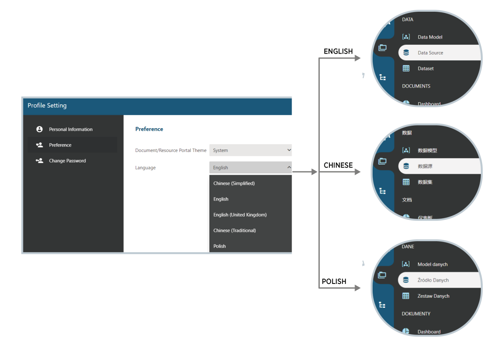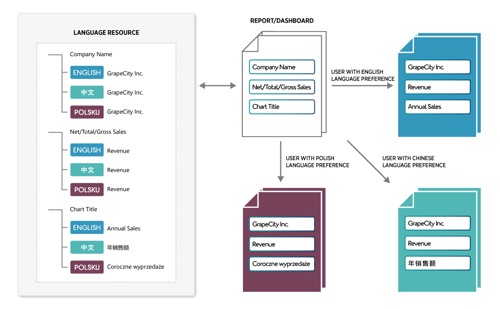-
Interactive DashboardsCreate interactive BI dashboards with dynamic visuals.
-
End-User BI ReportsCreate and deploy enterprise BI reports for use in any vertical.
-
Wyn AlertsSet up always-on threshold notifications and alerts.
-
Localization SupportChange titles, labels, text explanations, and more.
-
Wyn ArchitectureA lightweight server offers flexible deployment.
-
 Wyn Enterprise 7.1 is ReleasedThis release emphasizes Wyn document embedding and enhanced analytical express...
Wyn Enterprise 7.1 is ReleasedThis release emphasizes Wyn document embedding and enhanced analytical express... -
 Choosing an Embedded BI Solution for SaaS ProvidersAdding BI features to your applications will improve your products, better serve your customers, and more. But where to start? In this guide, we discuss the many options.
Choosing an Embedded BI Solution for SaaS ProvidersAdding BI features to your applications will improve your products, better serve your customers, and more. But where to start? In this guide, we discuss the many options.
-
Embedded BIEmbed reporting & analytics within your own custom apps.
-
Self-ServiceEnable users to create custom ad hoc reports and dashboards.
-
MultitenancyEnhance your SaaS apps with a multitenant BI platform.
-
Data Governance and ModelingTransform raw data into insights quickly to reveal trends.
-
Scheduled DistributionSend data insights via scheduled email and chat notifications.
-
Extensible SecurityWyn delivers extensible security for your access control needs.
-
Visual GalleryInteractive sample dashboards and reports.
-
BlogExplore Wyn, BI trends, and more.
-
WebinarsDiscover live and on-demand webinars.
-
Customer SuccessVisualize operational efficiency and streamline manufacturing processes.
-
Knowledge BaseGet quick answers with articles and guides.
-
VideosVideo tutorials, trends and best practices.
-
WhitepapersDetailed reports on the latest trends in BI.
-
 Choosing an Embedded BI Solution for SaaS ProvidersAdding BI features to your applications will impr...
Choosing an Embedded BI Solution for SaaS ProvidersAdding BI features to your applications will impr... -

How to Enhance Internationalization and Localization Using BI Tools
Introduction
Globalization is the new big thing with businesses, be it E-commerce, Finance, Airline, or many others. Every business is scaling itself to the global market in order to attract more customers or users and thus generate more revenue. However, one of the biggest challenges they face with globalization is making the products or services resonate with the target audience. To overcome this, the products/services are designed such that the users can easily understand and adapt to them, for example, making them available in the user’s regional/native language, having cultural diversity, and so on.
This makes Internationalization and Localization of products or services, an important step in the process of Globalization of a business.

Internationalization vs Localization
Both Internationalization and Localization intend to display (or present) the product in the user’s native language. Thus, these two terms are often used interchangeably. However, they are different.
While internationalization focus on making products adaptable to different markets, localization actually makes them adaptable to a specific market. Take, for example, a Product’s website. While Internationalization ensures that the content on the website is adaptable to resonate with foreign language users without the need for a total redesign, Localization ensures that the translated content appears for users of specific languages. Typically, localization is a step above internationalization and together they mark a product’s success in the global market.
Internationalization and Localization in Business Intelligence (BI)
The presence of Internationalization and localization cannot be underrated in Business Intelligence. Global businesses nowadays rely significantly on BI for analyzing data and making impactful insights with dashboards and report visualizations. So, it becomes important for BI tools to support Internationalization and Localization with visualizations and user interfaces.
Wyn Enterprise enhances its comprehensive business intelligence experience by offering support for localization and internationalization in several business use cases. In this blog, we’ll specifically cover the following use-cases:
- Localize Portals and Designers for native-language users
- Create Multi-Lingual documents (reports and dashboards)
- Build a Dictionary of the company’s standard texts or labels for globally shared documents
Localize Portals and Designers for Native-Language users
Many companies such as SaaS or large enterprises have customers or users from different parts of the world. These organizations look to display the pages or user interfaces of the deployed BI system or enterprise software in the user’s native language.
Wyn Enterprise allows users to select a display language from a list of languages on the Preference page of the user portals. The list includes,
- Officially supported languages – English (American and British), Chinese (Simplified and Traditional), and Polish
- User-defined translations using customized language packs

When the display language is changed by a user, words that are part of the Wyn Enterprise framework such as menu items, buttons, labels, texts, and messages are displayed in the selected language. However, words that are specific to a document, such as labels in a report, visualization titles in a dashboard, rich text, etc. are not translated with this setting. They are translated separately through language resources that we will see in the next use case.
Create Multi-Lingual Documents (Reports and Dashboards)
Often global users or customers prefer to see the documents (reports and dashboards) in their native languages. Typically in this scenario, a document author will create multiple reports and dashboards (one for each language) and then share them according to location/language using Roles/Organizations. However, this approach has potential gaps and requires enormous efforts to manage and keep the documents updated.
Wyn Enterprise supports dynamic text, labels, or content in a document so that the same document can be used across multiple language users. This eliminates the need to create and manage multiple copies of the same document. A Wyn document is made multi-lingual by attaching it to a Language Resource. It ensures that the content appears based on the language that is identified for the user requesting the document. That means a user who is requesting the document in English gets all labels, text, etc. in English while a user who is requesting the same document in Chinese will get the labels, text, etc. in Chinese as depicted in the image below:

Build a Dictionary of Company Standard Texts/Labels
When working with documents that have a global audience, most companies maintain and promote using a dictionary of certain texts/labels that are to be followed as standard across the global users or customers. Such a dictionary can include:
- A structured company’s demographics, such as the company name, address, contacts, etc.
- Defined title for visualizations, such as Annual sales, to be used across multiple dashboards or reports.
- Terms to have a uniform and unambiguous meaning, for example, total sales, gross sales, or net sales. These are often used interchangeably. However, they have specific meanings and may be interpreted differently by global users. So, the company can define a standard text, say Revenue for them.
Wyn Enterprise offers to build such a dictionary using a Language resource file. The business users can define the resource file with standard texts/labels and use it in document(s) as illustrated below:

Conclusion
Language packs and resources in Wyn Enterprise can help users meet most of the internationalization and localization needs with a BI tool in their business. Try it out and share your experience with us!

Paarisha Rana
As a software engineer, Paarisha enjoys the team environment of encouragement and learning. She enjoys reading, aerobics, travelling, and exploring historical places. Paarisha graduated from Uttar Pradesh Technical University (UPTU) at Lucknow (India) with a Bachelor’s of Technology in Information Technology, and you can find her on LinkedIn.
Don’t take our word for it.
See what our customers have to say.




Loved by industry
experts and real users
Whether it’s your business or your commercial SaaS app, embed Wyn and empower users to design, share, and distribute interactive dashboards and reports.












